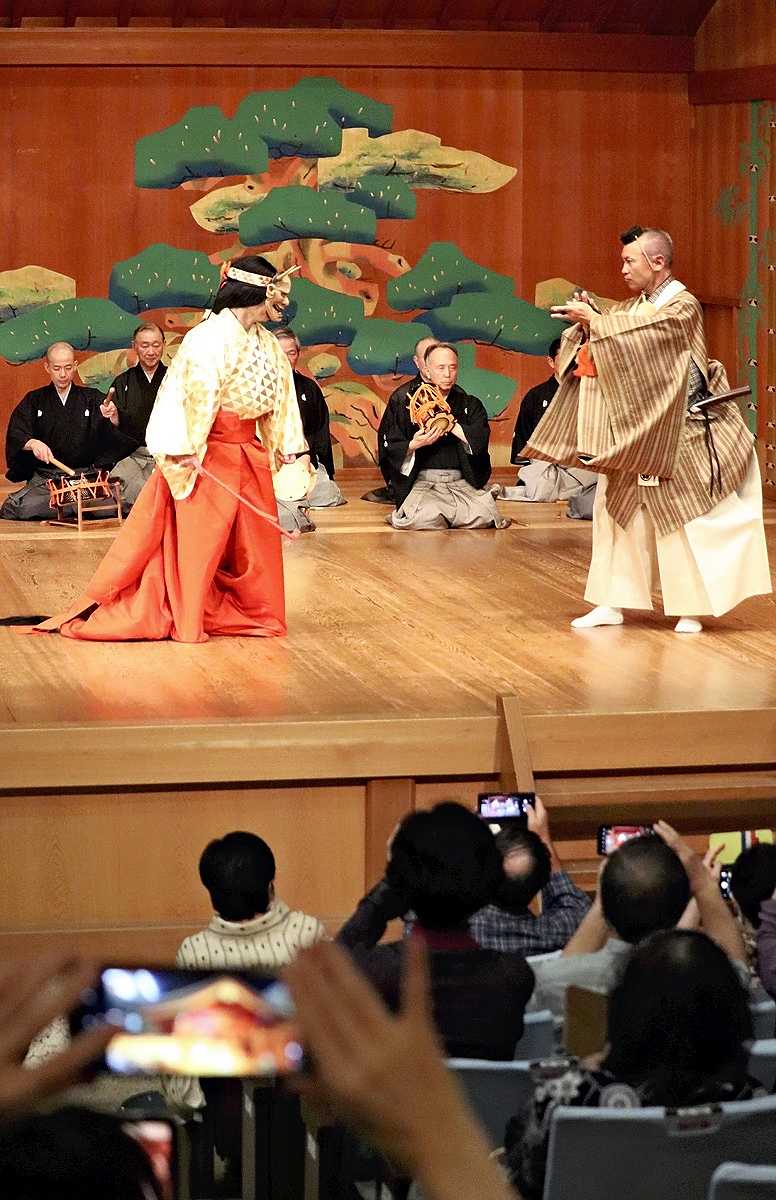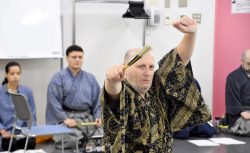‘Photo Time’ for Noh, Kabuki Audiences Spreading in Kansai Region; Traditional Arts Working to Draw in Audiences

Audience members take pictures of a reenacted noh play scene after the performance in this photo taken at the Kyoto Kanze Noh Theater in Sakyo Ward, Kyoto, in late August.
16:00 JST, November 3, 2024
KYOTO — “Photo time,” which provides an opportunity for audiences watching noh, kabuki and other traditional performing arts to take pictures of the stage and actors following the end of the performances, is spreading throughout the Kansai region.
Although photography is prohibited during performances, such an opportunity given to the audience is aimed at broadening the fan base of traditional performing arts by encouraging young people to share their experiences on social media, as many of them are unfamiliar with these time-honored arts.
Highlights reenacted
A show by the Kyoto Kanze Association which allowed photography was held at the Kyoto Kanze Noh Theater in Sakyo Ward, Kyoto, in late August.
After the show, which included performances of “Yokihi” and “Aoinoue,” had ended, kyogen performers stepped onto the stage and told the audience that they would then be allowed to take pictures of the stage and performers.
As Hayashikata, players of Japanese classical music instruments, began performing with Japanese flutes and drums, Rokujo-no-Miyasudokoro, the main character of “Aoinoue,” and a priest stepped dramatically onto the hashigakari bridge connecting the stage and the entryway curtain.
As the priest rubbed his prayer beads together to perform an exorcism on Rokujo-no-Miyasudokoro, who had been turned into a demon by her envy, in a reenactment of one of the highlights of the play, audience members could freely take photos with their smartphones.
This was the first attempt at “photo time” during a noh performance by the Kyoto Kanze Association.
Katayama Kuroemon, the 59-year-old chairman of the association, called from the stage for spectators to cooperate, saying, “We would like to see how much people will learn about noh plays by letting parts of them be shown on social media. I hope it will spread widely.”
Declining audiences

Noh performers are seen onstage in Taiwan in May.
A noh performance in Taiwan in May led the association to try the photography session in Japan. The association members performed an original piece themed around “Mazu,” a Taoist goddess who is worshipped in East Asia.
In theatrical performances in foreign countries, photography is often permitted during the curtain call.
After completing the entire program on the first day of performances, Kuroemon and other players gave a short performance that lasted about seven minutes, with highlights from the play reenacted for people to take pictures.
Audience members then posted the scenes on social media, saying things like “I was so moved” and “It was wonderful.” The performance was well-received, with the remaining two performances fully booked.
In the world of theatrical performances and musicals, where copyrights belong to creators of individual aspects of the work, including stage design and the script, there are high hurdles to allowing audiences to take photos.
Kuroemon said that, because noh plays are also performed as rituals and ceremonies, he had not previously considered allowing audiences to take photos of the stage and performers.
Still, he decided to take on this new challenge out of concern over the aging and declining of audiences at home.
According to a poll conducted last year by the Cultural Affairs Agency, only 2.7% of respondents said they had watched any traditional performing arts, such as noh, kyogen, kabuki or ningyo joruri, within the past year.
Kabuki leads the way
Kabuki was a step ahead of the other performing arts in lifting the ban on smartphones.
In the March program at the Minamiza Theatre in Kyoto, photo time has been provided since 2021 at the initiative of the actors.
The photos are an opportunity to passionately support their favorite actors on social media, with the photo opportunity reportedly proving popular among audiences, who have said things like “It’s innovative” and “I was happy.”
In the March program at Minamiza, the audience was asked to photograph the actors who were on the hanamachi, an elevated walkway running from the stage to the rear of the theater through the seating area, with the stage curtains closed so that the background stage artwork would not be seen in photos.
Normally, around 20-30% of kabuki play audiences are in their 20s or 30s at the theater, but during the March program, the audience in that age group made up nearly half of the audience on some days.
An official at Minamiza said, “We hope we can offer the audience some way to enjoy the performance that is in keeping with the times, while also drawing a clear line between what can and cannot be photographed.”
Related Tags
"Culture" POPULAR ARTICLE
-

Van Cleef & Arpels Dazzles with Art Deco Artisanry at Tokyo Exhibit
-

Disney’s ‘Twisted-Wonderland’ Animated Series Puts Villains in Spotlight: New Show Features School Inspired by Classic Disney Films
-

Japan Plans to Distribute Manga Overseas Via New Platform
-

Ayumi Hamasaki’s Shanghai Concert Canceled Day Before Schedule as Part of Beijing Backlash
-

‘The World Masterpiece Theater Series’ Celebrates 50 Years; Animator Looks Back on Creating Anime Classics
JN ACCESS RANKING
-

Keidanren Chairman Yoshinobu Tsutsui Visits Kashiwazaki-Kariwa Nuclear Power Plant; Inspects New Emergency Safety System
-

Imports of Rare Earths from China Facing Delays, May Be Caused by Deterioration of Japan-China Relations
-

University of Tokyo Professor Discusses Japanese Economic Security in Interview Ahead of Forum
-

Japan Pulls out of Vietnam Nuclear Project, Complicating Hanoi’s Power Plans
-

Govt Aims to Expand NISA Program Lineup, Abolish Age Restriction

























